
|
|
An Australian Pioneer - the Winner 10 cc Spark Ignition Engine By Maris Dislers
As a general note, all photographs are by Maris Dislers except where specifically otherwise attributed. Now, over to Maris …………………………….
Introduction July 3rd, 1935 - Mascot Aerodrome (now Sydney International Airport), Sydney, New South Wales, Australia ………………. With a few deft flicks, “engine expert” Sidney Taberlet started the Brown Junior engine and adjusted the controls until it was bang on tune. The reliable and powerful Brown engine from America was just what his best friend, future Australian control-line speed champion Jack Finneran, was counting on to power his “Miss Texaco” model. Jack took hold of t There was a full report in the following day’s July 4th, 1935 issue of The Sydney Morning Herald newspaper. It included a fine air-to-air photo of the model on its second and longer flight, taken from the back seat of Captain Follett’s Klemm Swallow. The publicity stunt for Texaco petrol (gasoline) and oil had gone very well, to the point that this event inspired quite a number of Aussie aeromodellers to seriously consider taking up power flying. However, there was a problem! Commercial model engines were then of course overwhelmingly produced in the USA. Moreover, prices of these units were really steep owing to hefty import tariffs aimed at limiting capital outflow and protecting Australian industry. The inevitable result of this unfavourable supply-and-demand situation was the appearance of a few locally-made engines which trickled onto the domestic Australian market. In design terms, these were largely influenced by the better American types of the day. One example was the Austral Tornado of around 7-10 cc displacement made by the Austral Model Aircraft Co. of Hawthorn, Melbourne. An article on the Austral engines by the late David Owen remains accessible on the late Ron Chernich’s “Model Engine News” (MEN) website. There was also the Walther (basically a clone of the Baby Cyclone from America) made locally for the Walther and Stevenson toy store in Sydney. The Winner is another equally scarce Australian engine of that pre-war period. Essentially copied from the Brown Junior, the Winners were marketed by Reginald Payne, owner of Payne’s Sports Goods Stores. Beyond the fact that he was based in Melbourne, Victoria, nothing is known about the actual manufacturer. Editor's note: Following the initial appearance of this article, reader Andrew Fullarton of Australia contacted the Editor to draw attention to an article which appeared in the now-defunct Australian aeromodelling magazine "Airborne" in issue no. 56 for March/April 1983. This article was written by Andrew's late father Jim Fullarton. The main subject was an amphibian model aircraft of 1937 which had been converted by Eric Ehrenberg from rubber power to I/C power. There was a photo of the engine which, like the Winner, looked a lot like like a Brown Junior. Andrew's Dad stated that this engine was made by “the late Bert Machin”. When Andrew read this article in 2016, he concluded that the engine might in fact be a Winner. His father Jim was still alive at the time. Andrew asked his Dad if he could recall the chap who made the engine. Jim's memory was then failing and all he could remember was that it was made by "someone who worked for an automotive parts firm in Melbourne". These two snippets of information led Andrew to the conclusion that the engine was made by the automotive parts and accessories firm of E. A. Machin and Co. of Elizabeth Street, Melbourne. Our sincere thanks to Andrew for sharing this information! However, that doesn't necessarily make the engine a Winner! Apparently there were a number of Brown Junior look-alikes circulating in Australia at this time. Prior to writing the original article, Maris had spoken with both Jim Fullarton and Alwyn Lim Joon regarding the Winner. At that time, neither could add any definitive information to settle this point. Maris considers that Chas Lambeth's recollections ("Pioneers of Model Aviation in Australia", John Marquette) contain some important clues. To quote: "Numerous local engines were produced and to name some: the Winner, a Brown Junior look-alike marketed by Reg Payne; the Tornado by Austral Aircraft and the Gordon Machin engine......I remember well the Ehrenberg amphibian twin rubber-powered model of eight feet span converted to gas via a Machin engine." This quote is taken from Chas' recollections of modelling in Melbourne at that time. The above statement clearly implies that the Winner and the "Machin engine" were in fact distinct productions, both based upon the Brown Junior. This being the case, both models were bound to look a lot like a Brown and hence like one another! Maris is not aware of any extant Machin engine. Indeed, Machin's engines might never have become available commercially - A.D. The Winner in Print
The report on the “Grand International Model Airplane Championships” (effectively the first Australian Nationals) mentions the Winner engine. The petrol-driven event was held on March 27th, 1938 at Richmond Aerodrome, west of Sydney. It was a duration competition for motors rated at up to 1/3 h.p. with 2 cc of fuel per pound of model weight. The report in Worlds News lists Winners among the ten engine types used by competitors alongside Brown Juniors, Baby Cyclones That report carried a photo of “the most unusual job at the contest” – John White’s gull-winged pod and boom design powered by a Winner engine swinging a single bladed propeller. Apologies for the very poor quality of the attached reproduction of this image, but any image is surely better than none! Stan Parkinson won this competition using his home-made engine (1” bore, 7/8” stroke, 1/3 h.p.) in a Ben Shereshaw designed “Nimbus”, clocking 9m 52s before flying out of sight in rather poor weather conditions. However, the Winner’s highest claim to fame was powering H. J. MacKay’s own designed “Gas Champ” to first place at the 2nd Australian National Championships in November 1939, which were run to the new 20 second engine-run rules. Plans for the model are listed in John Pond's catalogue. Thereafter, the only reported written reference to these engines is an attested advertisement in a contemporary magazine that has so far eluded us. We Got One!
But all was not lost! A relatively complete and restorable example came my way recently as part of a deal to buy a smaller 6 cc engine which was also thought to be a Winner. More on that one later. The Winner copies all of the principal elements of the 1937 Brown Junior “C” engine, including the Brown’s newly-introduced simplified venturi tube and ringed aluminium piston. However, it retains the earlier cylindrical fuel tank style as seen on the Brown Junior "B" illustrated above. Overall, it must be admitted that the construction quality of the Winner falls well short of that of the Brown. The manufacture of these engines may have been a sideline for a small general engineering business at a time when skilled tradesmen routinely made all sorts of things that they could sell. However, such individuals would probably have had no prior experience in meeting the challenge of making miniature engines to the required standards of precision.
The potential for restoration hinged on whether the sandcast crankcase could be rebuilt. Although rough, the alloy proved to be of good quality. This allowed a new lug to be successfully welded on. I whittled the new lug to shape and made a new conrod while waiting for fresh rings from “Ringmaster” Frank Bowman (now sadly retired). David Zwolak put out the word for a replacement genuine Brown Junior crankshaft, with Bob Watts answering the call. Big thanks to both! The engine went together nicely from there, including practicing the genteel art of sanding the paper gasket down to exact thickness for correct cylinder alignment. Structural Stuff
The steel cylinder with its brazed-on The sandcast crankcase has a bronze-bushed crankshaft bearing and is threaded for the cylinder and cast back plate. It has “MS 200” stamped onto the LH mounting lug. The meaning is unknown, but given this engine’s extreme rarity, it’s highly unlikely to be the 200th one made. The unhardened crankshaft appears to be a forged steel item with a ground finish on journal and crankpin. Prop driver and timer assembly follow the contemporary Brown design. The bare engine without tank or ignition gear weighs 210 gm (7.4 ounces). On the Bench
That done, the engine was converted back to spark ignition and run using a 3:1 petroil mix. We used Harley Davidson SAE 50 oil, for want of anything more suitable. The Winner started just as easily and in the right direction, thanks to the initially retarded ignition setting. In the 32 degree Celcius heat which prevailed at the time, it was unhappy holding top revs for long, but Don Howie and I obtained the following readings.
Our estimated power outputs imply that the Winner is close to the Brown Junior in performance, substantiating the 1/5 BHP claim. Certainly it’s a low revving type, going by the tendency to miss at higher RPM. Don suggested that we try the old remedy of fitting a rubber band around the timer assembly, increasing spring pressure on the moving point, for improved high speed running. But then it would no longer be “authentic”. Of course, most folk use methanol fuel now, and we’d expect the Winner with its limited cooling fin area to be much happier that way. Going on our spot checks when running with glow-plug, and with the rubber band remedy, using that fuel might gain around 1,000 RPM, lifting peak power to a almost 0.4 BHP at around 7,000 RPM. A Mini Winner? The primary object of our original purchase from Doug Grinham was a smaller engine, also claimed to be a Winner. Clearly inspired by the Brown Junior design, this one has bore and stroke measurements of 20.07 mm and 19.23 mm respectively, giving a swept volume of almost exactly 6 cc (0.37 cuin.). It uses British Sadly, all those with firsthand experience and knowledge of the Winner engines have now passed on. Speculation abounds, but with no verifiable provenance, this smaller engine must remain a tantalising “wotizit” mystery. If any reader can shed light upon this engine’s origins, we’d be most grateful to hear from you!! (Editor's note - to me, it actually appears more likely than not that this is a very competently executed "Mini-Brown" made by some long-forgotten model engineer, rather than a Winner product. If both the 10 cc Winner and the "Mini-Winner" were independently copied from the Brown by their respective makers, you'd expect them to look very similar, with perhaps a few structural differences. For me, it's the superior workmanship as well as the use of a lapped piston that seems to imply a model engineering origin for the "Mini-Winner" - A.D.) Conclusion As time went by, increasing competition in the American market pushed down the prices of engines from that source. This enabled enterprising Aussies to import alternatives to the Brown Junior, such as the Bunch engines in kit form, at a much more friendly price. This would not have helped the cause of the various Australian-made designs. As an interesting aside, Kellogg’s had an interest in aviation at that time as a vehicle for promotion of their products. The previously-mentioned Mascot Aerodrome was on their land, adjacent to their Sydney breakfast cereal factory. As one of their promotions, Kellogg’s sponsored the popular “Howie Wing” radio serial between 1938 and January 1940. Lots more information on that show can be found here, including three recorded episodes.
Given the increasing popularity of aeromodelling at the time, this was clearly a good way for Kellogg’s to gain market share. Oddly enough, South Australians didn’t even need to send any box tops to get the reduced prices! Once again, this promotion must have impacted negatively on the viability of fledgling low-volume model engine makers in Australia. The outbreak of war in 1939 severely curtailed power model flying in Australia and elsewhere. Supplies of just about everything from the USA ceased in early 1942 and by then the only engines around might have been a few heavy 8.5 cc Whirlwinds or Vanguard Pups (another Baby Cyclone copy) from The Model Dockyard in Melbourne. Rapid post-war developments in model engine design left the old stuff well behind and almost forgotten. With all that “headwind”, it’s not surprising that examples of the Winner and other pre-war Australian engines are few and far between today. However, interest has simmered away among a few collectors and is on the way up at last. Hopefully this may result in the discovery and preservation of a few more examples as time goes by. My sincere thanks go to all who contributed to the Winner’s resurrection. We very much hope that this report brings forward further information on this Australian pioneering effort. _______________________________ Article © Maris Dislers, Adelaide, South Australia First published April 2016 |
||
| |
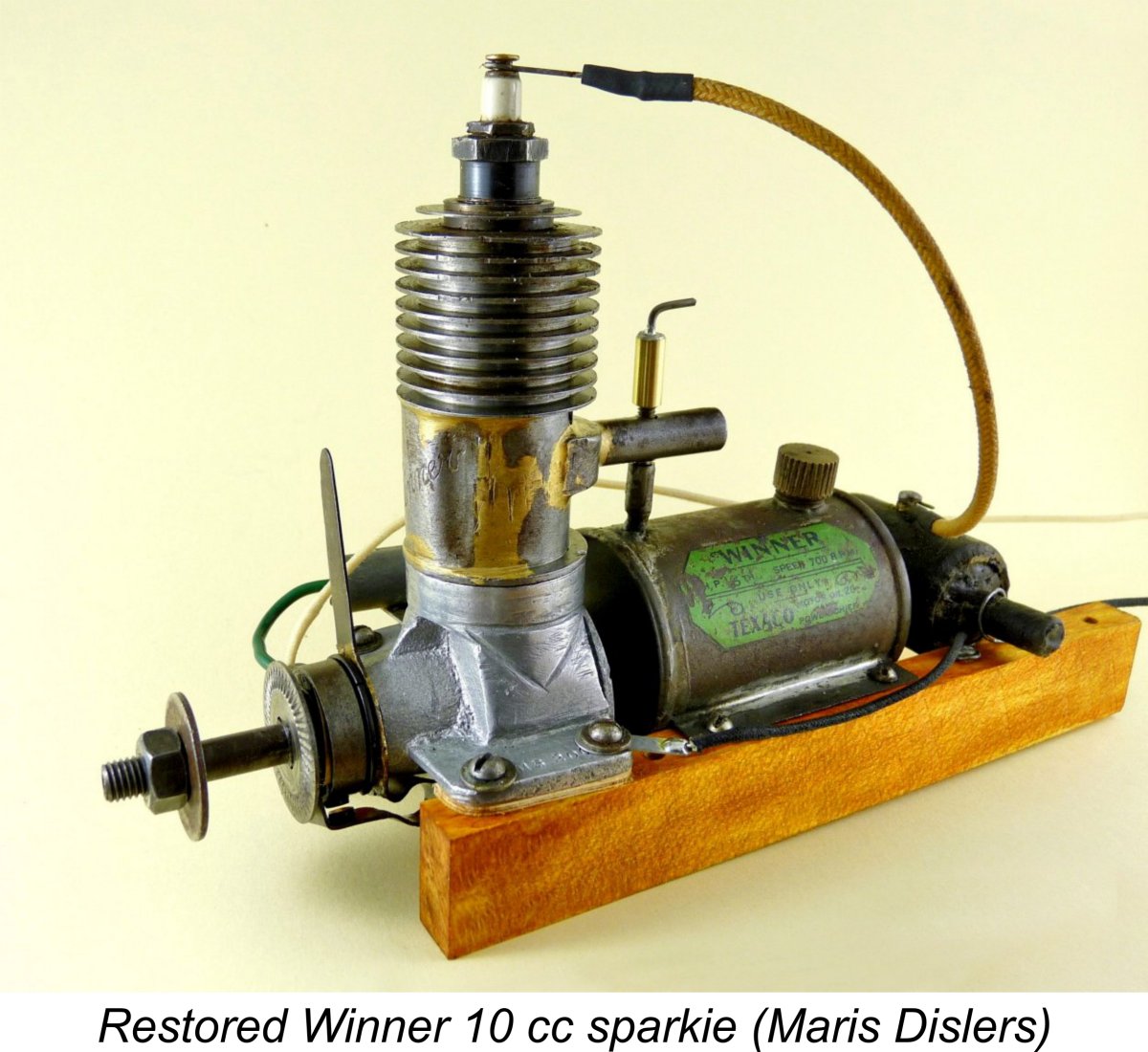 Editor’s note – the following article was prepared specifically for publication on this website by my very good mate and valued colleague Maris Dislers of Adelaide, South Australia (my own birthplace). It tells the fascinating tale of a pioneering model engine manufacturing effort from 1930’s Australia. Before turning the pen over to Maris, I just wanted to openly express my very sincere appreciation for his effort. It’s assistance like this from my fellow enthusiasts that will keep this site alive and growing far longer than I could manage on my own and will also ensure the preservation of some stories (like this one) that would otherwise be lost forever. Thanks, mate!
Editor’s note – the following article was prepared specifically for publication on this website by my very good mate and valued colleague Maris Dislers of Adelaide, South Australia (my own birthplace). It tells the fascinating tale of a pioneering model engine manufacturing effort from 1930’s Australia. Before turning the pen over to Maris, I just wanted to openly express my very sincere appreciation for his effort. It’s assistance like this from my fellow enthusiasts that will keep this site alive and growing far longer than I could manage on my own and will also ensure the preservation of some stories (like this one) that would otherwise be lost forever. Thanks, mate!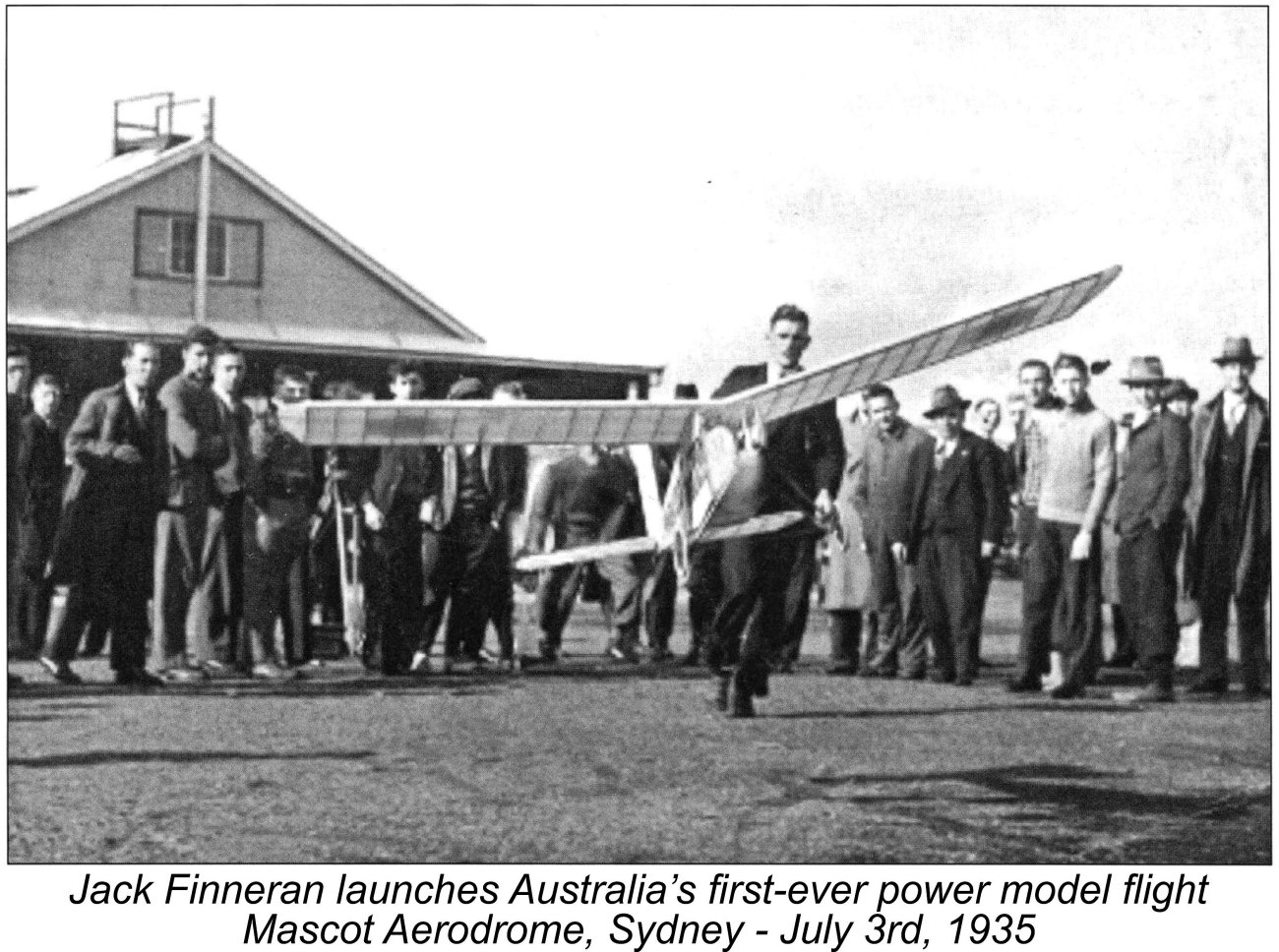 he model after checking that the Texaco executives and other sightseers (apart from the press photographer!) were safely behind him on the apron in front of the Aero Cub of NSW’s clubhouse at Mascot Aerodrome. With a nod to the photographer, he pointed the big high wing cabin model into the breeze and released it on the first petrol-powered model aircraft flight in Australia. The intrepid photographer stood his ground in the flight path to capture the moment perfectly in the shot reproduced at the right.
he model after checking that the Texaco executives and other sightseers (apart from the press photographer!) were safely behind him on the apron in front of the Aero Cub of NSW’s clubhouse at Mascot Aerodrome. With a nod to the photographer, he pointed the big high wing cabin model into the breeze and released it on the first petrol-powered model aircraft flight in Australia. The intrepid photographer stood his ground in the flight path to capture the moment perfectly in the shot reproduced at the right. 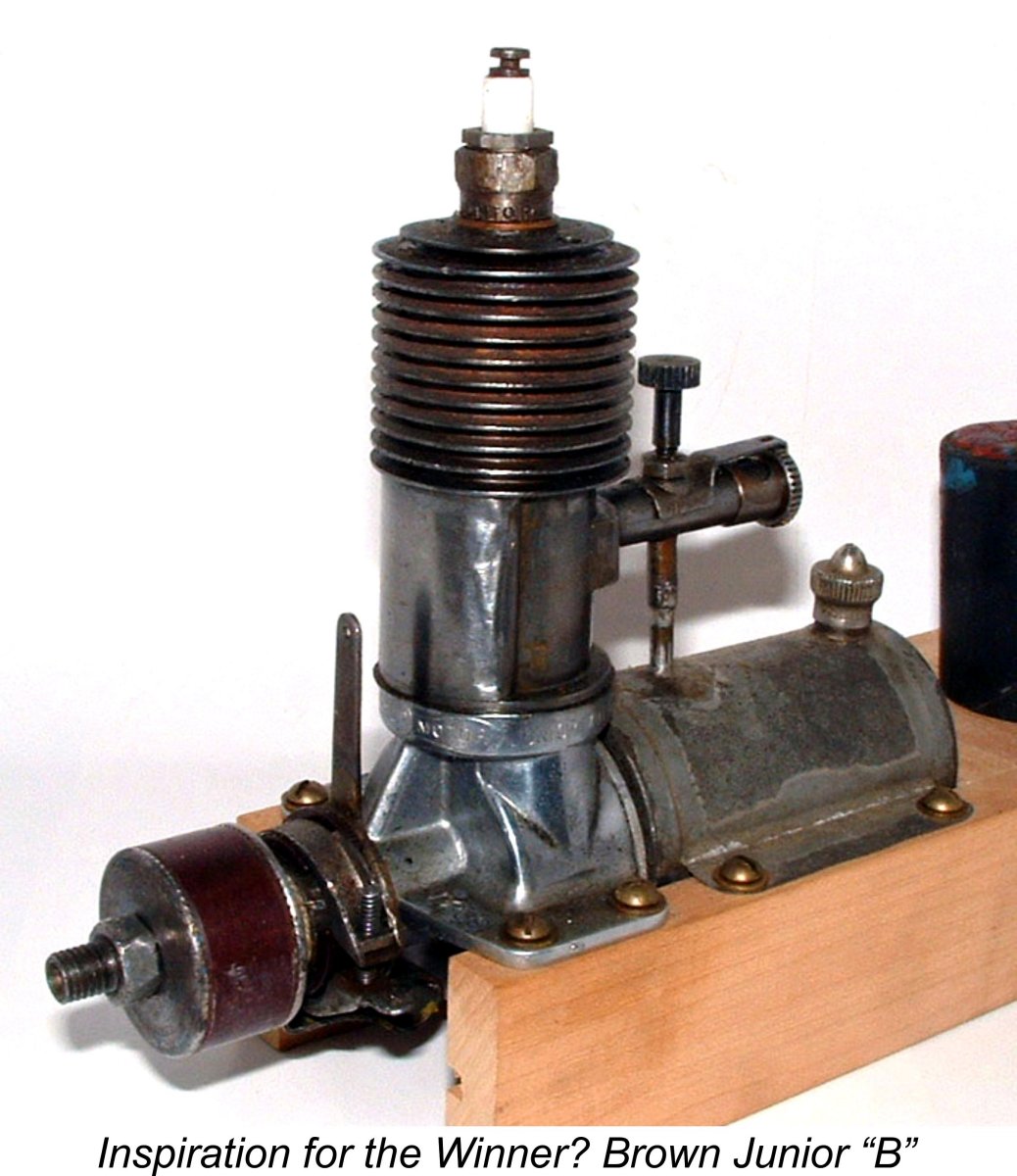 References to this engine in the contemporary media are few. The Winner was listed in an undated catalogue put out by Model Flying Co. Pty. Ltd. of 503 George Street in Sydney. Details provided were - Bore
References to this engine in the contemporary media are few. The Winner was listed in an undated catalogue put out by Model Flying Co. Pty. Ltd. of 503 George Street in Sydney. Details provided were - Bore 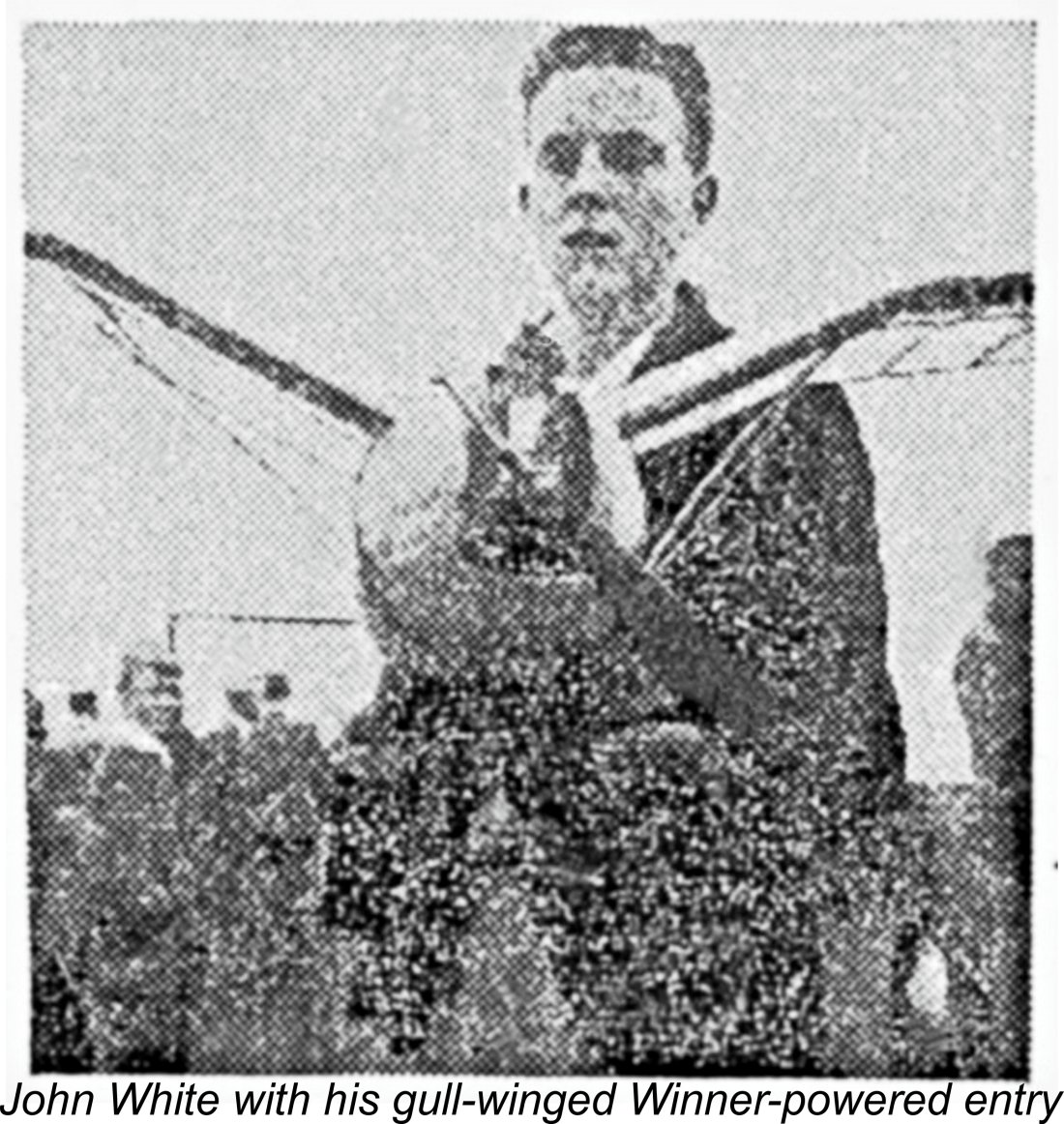 (two types), Bunch Gwin Aeros, Forster 99, Loutrels, Bunch Mighty Midgets, a Brat, and a Parkinson home-built unit.
(two types), Bunch Gwin Aeros, Forster 99, Loutrels, Bunch Mighty Midgets, a Brat, and a Parkinson home-built unit. We currently know of around six Winners in existence, although there may be more out there ………….however, only a few of these are available for examination. Some years ago, the late David Owen photographed the one illustrated at the left, still mounted in its skid with tank and ignition gear. However, David subsequently lost contact with the owner.
We currently know of around six Winners in existence, although there may be more out there ………….however, only a few of these are available for examination. Some years ago, the late David Owen photographed the one illustrated at the left, still mounted in its skid with tank and ignition gear. However, David subsequently lost contact with the owner.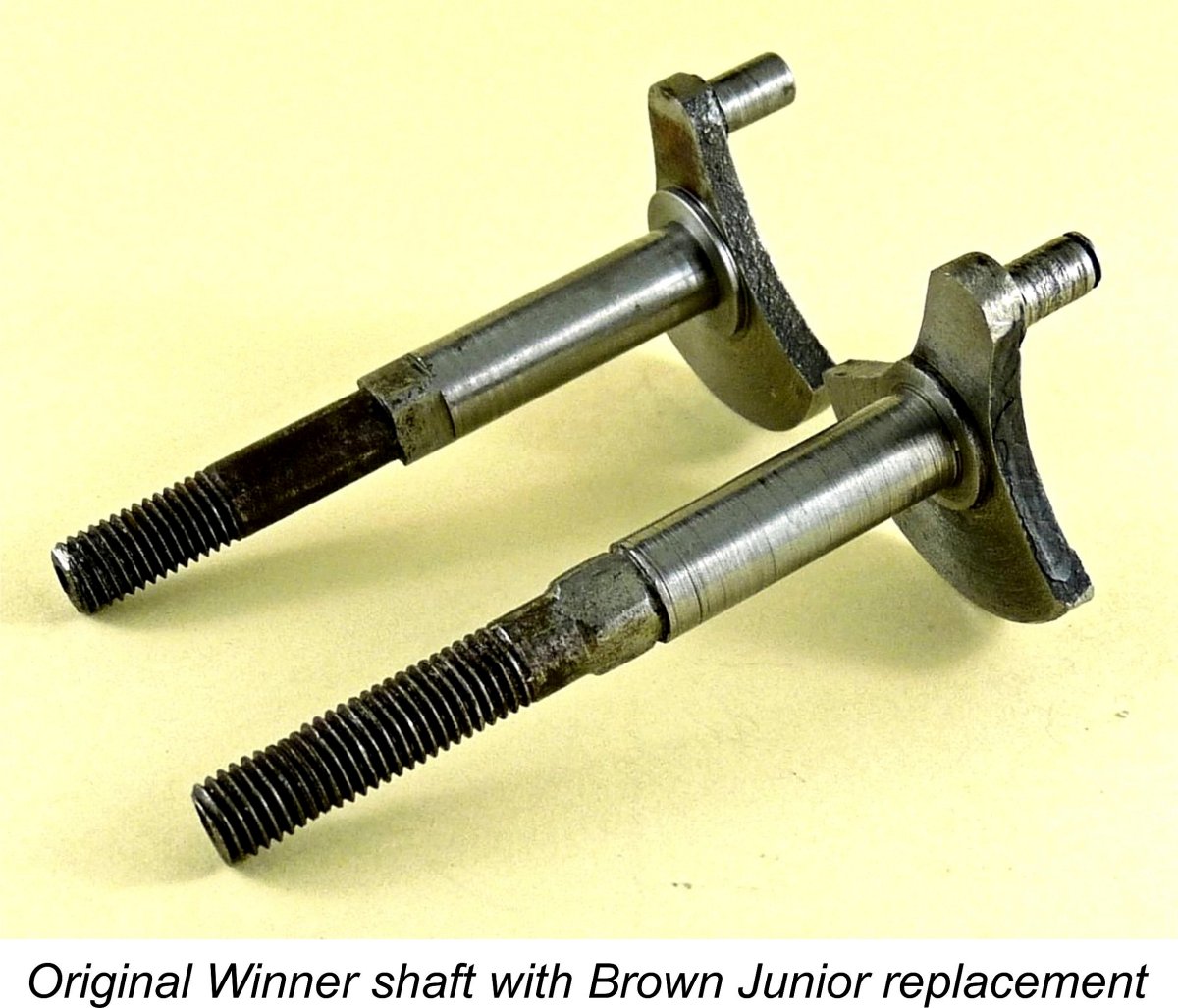 Our Winner engine was in poor shape after spending many years in the original owner’s shed near Camperdown, Victoria (150 km SW of Melbourne). It was still mounted to the remnants of the bearers by its remaining left hand lug (the right lug was missing) and had no mixture needle or spark plug. Internally, one piston ring was gone and the crankpin was shot thanks to the dreadful finish on the conrod’s big end bearing surface. Interestingly, the engine showed no visible evidence of ever having had the impressive swept-back exhaust stacks seen on the previously-illustrated example photographed by David Owen.
Our Winner engine was in poor shape after spending many years in the original owner’s shed near Camperdown, Victoria (150 km SW of Melbourne). It was still mounted to the remnants of the bearers by its remaining left hand lug (the right lug was missing) and had no mixture needle or spark plug. Internally, one piston ring was gone and the crankpin was shot thanks to the dreadful finish on the conrod’s big end bearing surface. Interestingly, the engine showed no visible evidence of ever having had the impressive swept-back exhaust stacks seen on the previously-illustrated example photographed by David Owen. 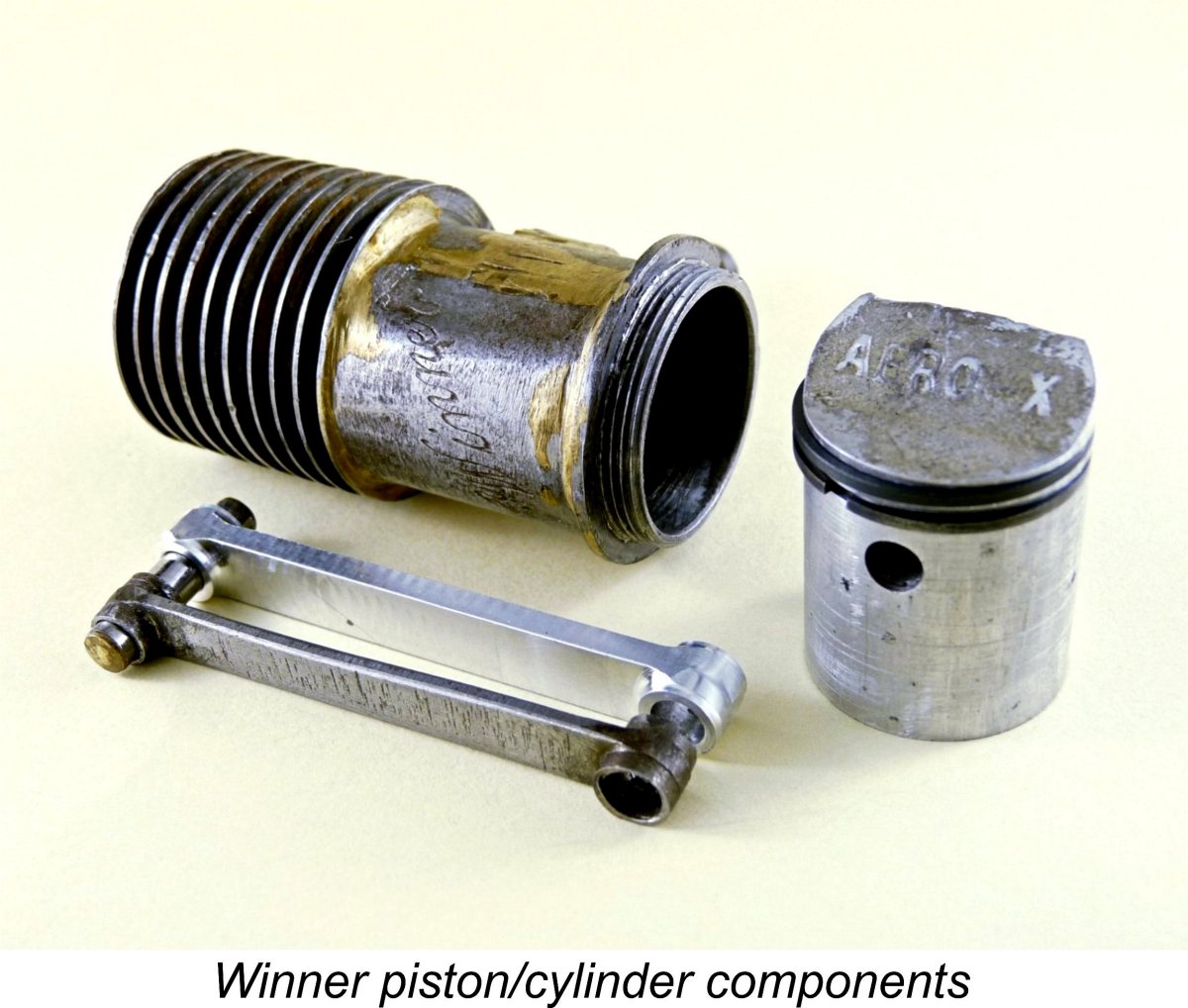 From a modern perspective, the Winner internals look decidedly spindly! However, they were clearly up to the job of delivering the claimed levels of performance. Of particular interest is the neatly die-cast (permold) piston with “Aero-X” on the buttress-shaped baffle. It carries a
From a modern perspective, the Winner internals look decidedly spindly! However, they were clearly up to the job of delivering the claimed levels of performance. Of particular interest is the neatly die-cast (permold) piston with “Aero-X” on the buttress-shaped baffle. It carries a 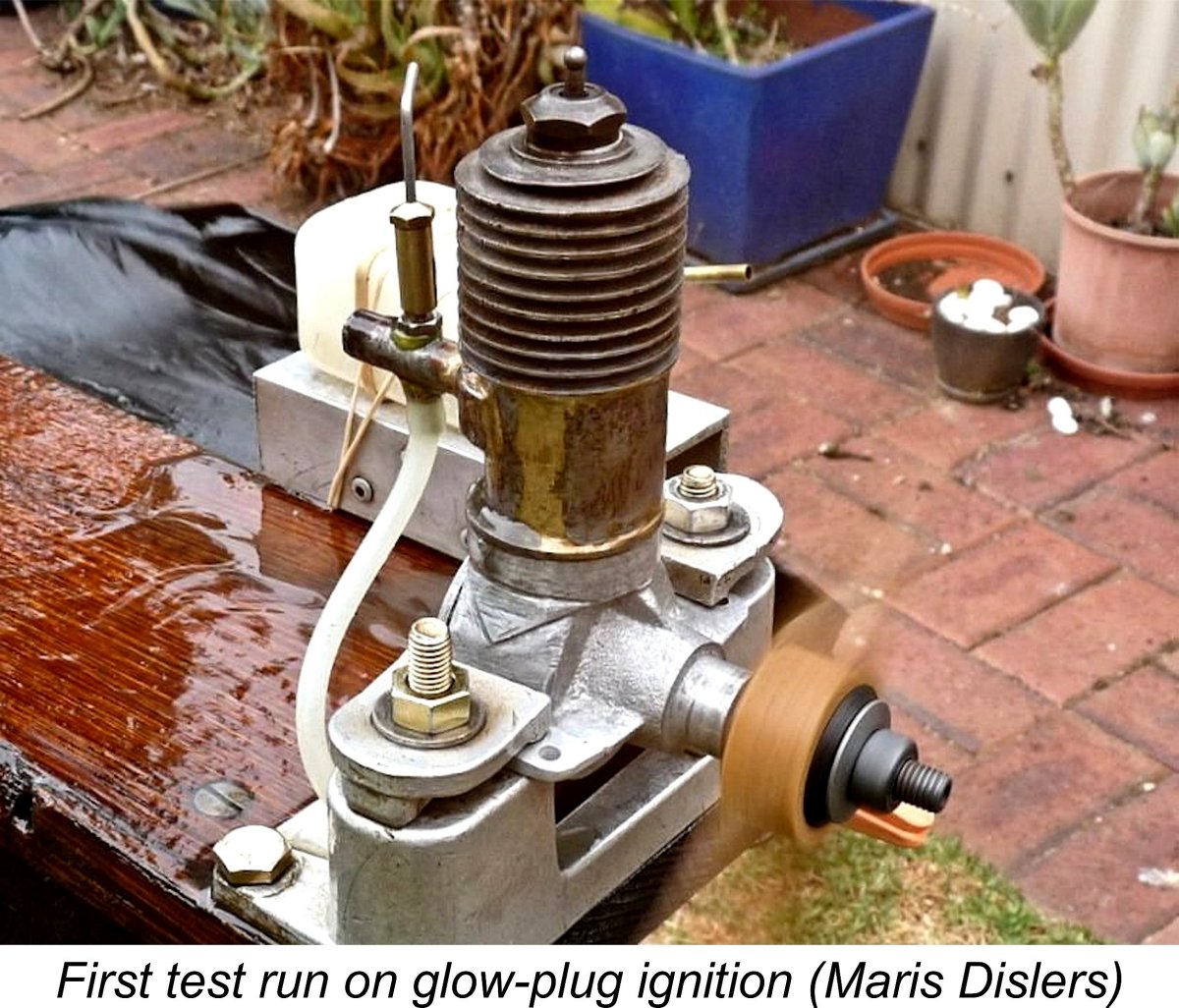 We ran in the rebuilt engine with an O&R glow-plug, using fuel containing 5% nitro and 25% castor oil, the balance being methanol. Easy peasy! A couple of finger chokes, a few drops of fuel on top of the piston and it was going within one or two flicks, albeit not necessarily in the desired direction! Even if flicked in reverse, the Winner often started backwards. Running was smooth and unfussed, although it tended to run hot if leaned out for extended periods at peak RPM.
We ran in the rebuilt engine with an O&R glow-plug, using fuel containing 5% nitro and 25% castor oil, the balance being methanol. Easy peasy! A couple of finger chokes, a few drops of fuel on top of the piston and it was going within one or two flicks, albeit not necessarily in the desired direction! Even if flicked in reverse, the Winner often started backwards. Running was smooth and unfussed, although it tended to run hot if leaned out for extended periods at peak RPM.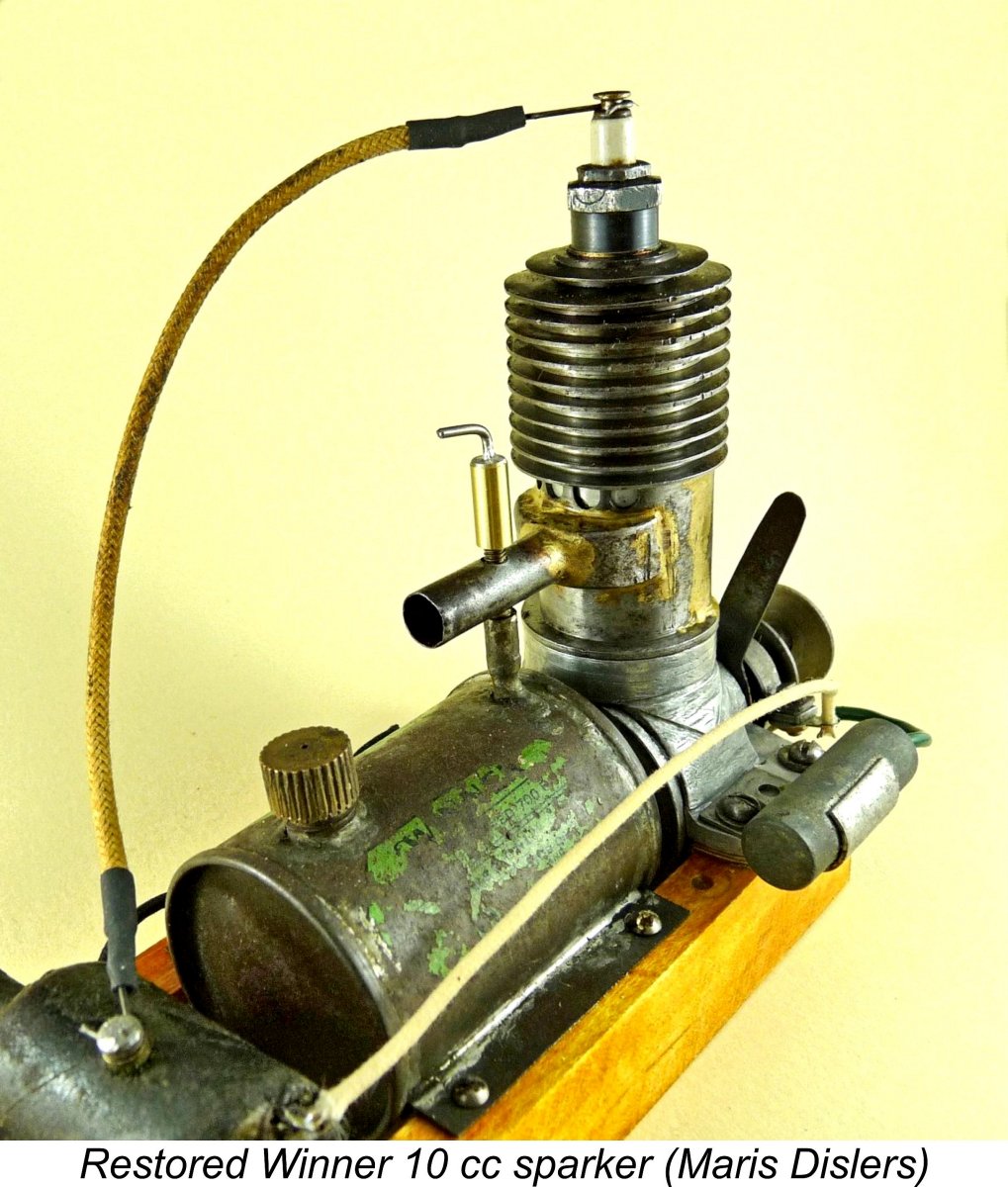
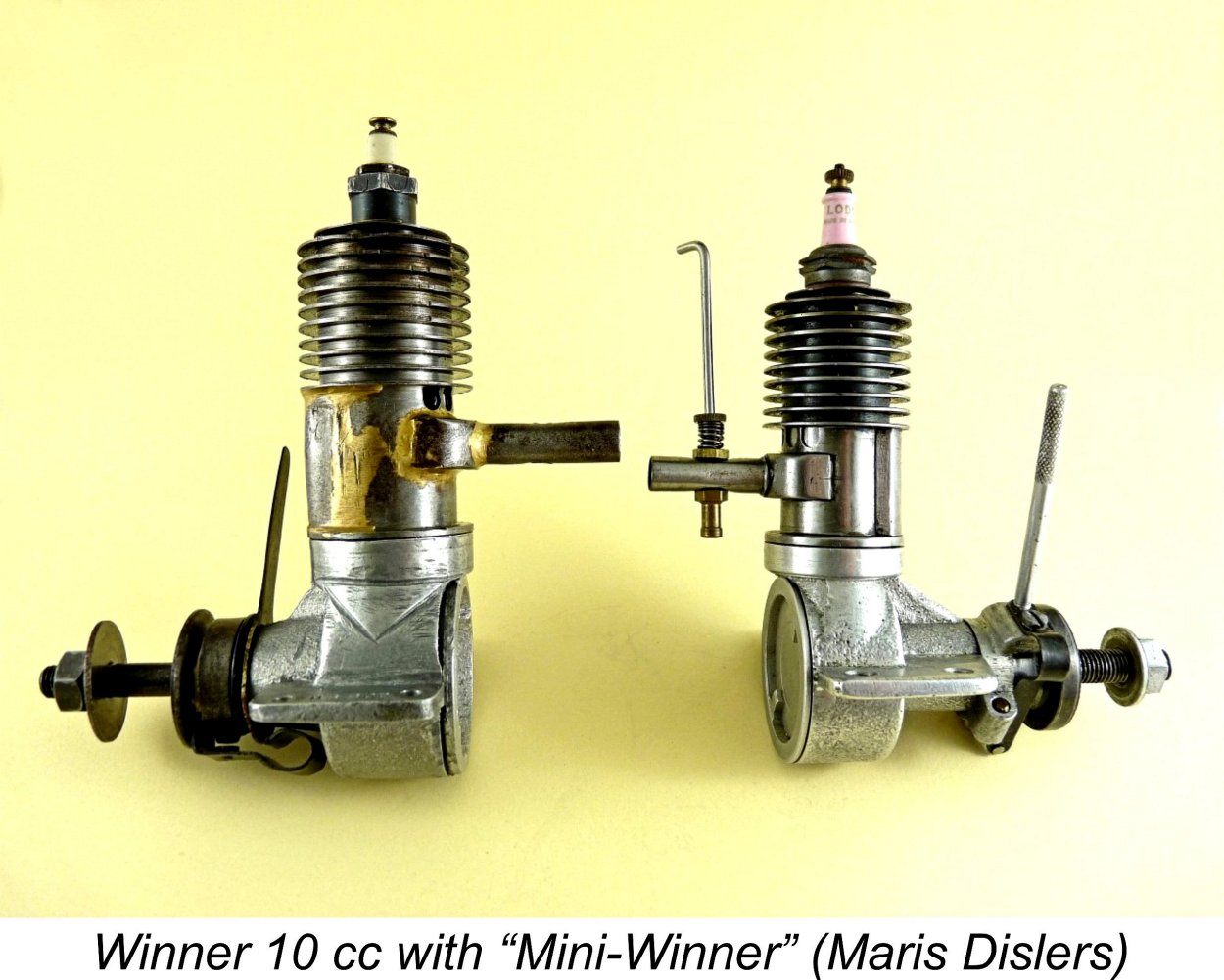 threads, but gives no other clues to its origin. No, it’s not a Ranger “B” (the closest we could find in Tim Dannels’ invaluable “
threads, but gives no other clues to its origin. No, it’s not a Ranger “B” (the closest we could find in Tim Dannels’ invaluable “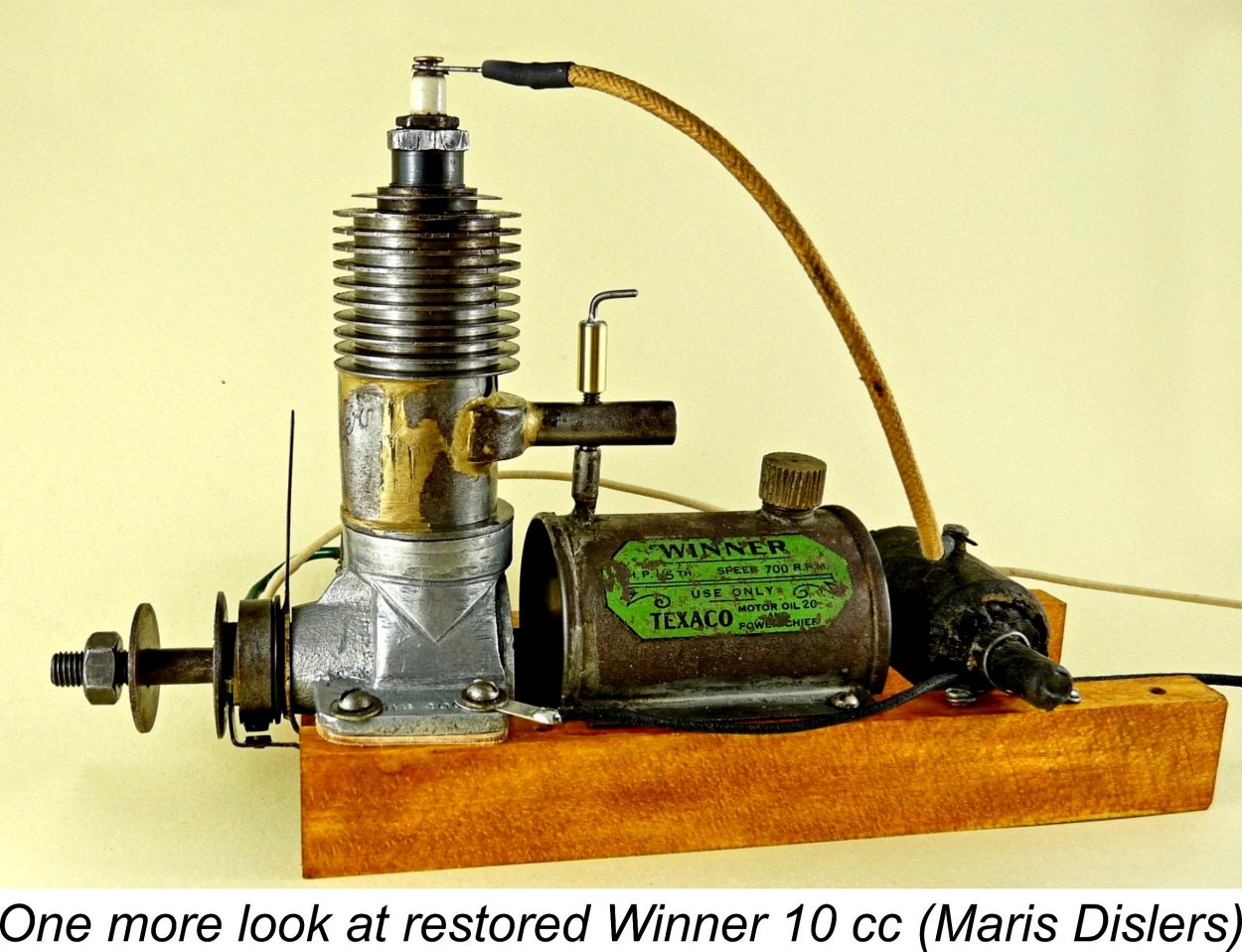 Listeners to the show could send in a few Corn Flakes or Rice Bubbles box tops and become members of the Howie Wing Cadet Club, complete with badge, certificate and a handbook containing rules, along with the opportunity to purchase discounted aeromodelling merchandise on a “box tops plus money” basis. As an example, membership enabled interested Aussies to obtain a Brown Junior “B” engine for £8 and 12 box tops, or the cheaper “D” model for only £4/15/- (£4.75) and 12 box tops.
Listeners to the show could send in a few Corn Flakes or Rice Bubbles box tops and become members of the Howie Wing Cadet Club, complete with badge, certificate and a handbook containing rules, along with the opportunity to purchase discounted aeromodelling merchandise on a “box tops plus money” basis. As an example, membership enabled interested Aussies to obtain a Brown Junior “B” engine for £8 and 12 box tops, or the cheaper “D” model for only £4/15/- (£4.75) and 12 box tops.